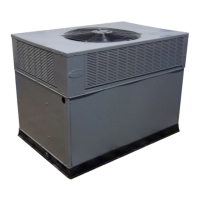HEAT ANTICIPATOR SETTING — The room thermostat heat
anticipator must be properly adjusted to ensure proper heating
performance. Set the heat anticipator, using an ammeter between
the W and R terminals to determine the exact required setting.
NOTE: For thermostat selection purposes, use 0.18 amp for the
approximate required setting.
Failure to make a proper heat anticipator adjustment will result in
improper operation, discomfort to the occupants of the conditioned
space, and inefficient energy utilization; however, the required
setting may be changed slightly to provide a greater degree of
comfort for a particular installation.
TRANSFORMER PROTECTION — The transformer is of the
energy-limiting type. It is set to withstand a 30-second overload or
shorted secondary condition.
PRE-START-UP
Failure to observe the following warnings could result in
serious injury or death:
1. Follow recognized safety practices and wear protective
goggles when checking or servicing refrigerant system.
2. Do not operate compressor or provide any electric power to
unit unless compressor terminal cover is in place and
secured.
3. Do not remove compressor terminal cover until all electri-
cal sources are disconnected.
4. Relieve and recover all refrigerant from both high- and
low-pressure sides of system before touching or disturbing
anything inside terminal box if refrigerant leak is suspected
around compressor terminals.
5. Never attempt to repair soldered connection while refrig-
erant system is under pressure.
6. Do not use torch to remove any component. System
contains oil and refrigerant under pressure. To remove a
component, wear protective goggles and proceed as fol-
lows:
a. Shut off gas supply and then electrical power to unit.
b. Relieve and reclaim all refrigerant from system using
both high- and low-pressure ports.
c. Cut component connecting tubing with tubing cutter and
remove component from unit.
d. Carefully unsweat remaining tubing stubs when neces-
sary. Oil can ignite when exposed to torch flame.
Proceed as follows to inspect and prepare the unit for initial
startup:
1. Remove access panel.
2. Read and follow instructions on all DANGER, WARNING,
CAUTION, and INFORMATION labels attached to, or
shipped with, unit.
3. Make the following inspections:
a. Inspect for shipping and handling damages such as broken
lines, loose parts, disconnected wires, etc.
b. Inspect for oil at all refrigerant tubing connections and on
unit base. Detecting oil generally indicates a refrigerant
leak. Leak test all refrigerant tubing connections using
electronic leak detector, halide torch, or liquid-soap solu-
tion. If a refrigerant leak is detected, see Check for
Refrigerant Leaks section on page 13.
c. Inspect all field- and factory-wiring connections. Be sure
that connections are completed and tight.
d. Inspect coil fins. If damaged during shipping and handling,
carefully straighten fins with a fin comb.
4. Verify the following conditions:
Do not purge gas supply into the combustion chamber. Do not
use a match or other open flame to check for gas leaks.
Failure to follow this warning could result in an explosion
causing serious injury or death.
a. Before lighting the unit for the first time, perform the
following with the gas valve in the "OFF" position: If the
gas supply pipe was not purged before connecting the unit,
it will be full of air. It is recommended that the ground joint
union be loosened, and the supply line be allowed to purge
until the odor of gas is detected. Never purge gas lines into
a combustion chamber. Immediately upon detection of gas
odor, re-tighten the union. Allow 5 minutes to elapse, then
light unit.
b. Make sure that condenser-fan blade is correctly positioned
in fan orifice. Leading edge of condenser-fan blade should
be 1/2 in. maximum from fan orifice (see Fig. 17).
c. Ensure fan hub is 1/8 in. max from motor housing.
d. Make sure that air filter(s) is in place.
e. Make sure that condensate drain trap is filled with water to
ensure proper drainage.
f. Make sure that all tools and miscellaneous loose parts have
been removed.
START-UP
Use the Start-Up Checklist supplied at the end of this book, and
proceed as follows:
CHECK FOR REFRIGERANT LEAKS — Proceed as follows to
locate and repair refrigerant leaks and charge the unit:
1. Locate leak and make sure that refrigerant system pressure has
been relieved and refrigerant recovered from both high- and
low-pressure ports.
2. Repair leak following accepted practices.
NOTE: Replace filter drier whenever the system has been opened
for repair.
3. Check system for leaks using an approved method.
4. Evacuate refrigerant system and reclaim refrigerant if no
additional leaks are found.
5. Charge unit with R-410a refrigerant, using a volumetric-
charging cylinder or accurate scale. Refer to unit rating plate
for required charge.
Fig. 17—Fan Blade Clearance
C99009
FAN GRILLE
MOTOR
1/8" MAX BETWEEN
MOTOR AND FAN HUB
MOTOR SHAFT
13

